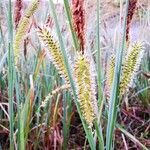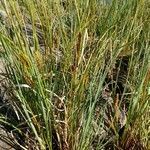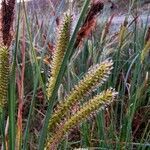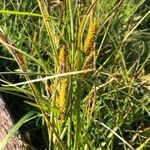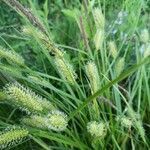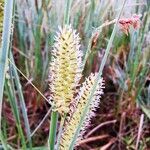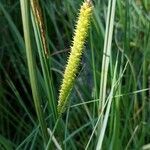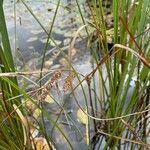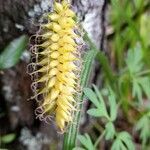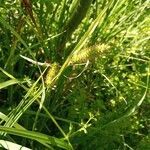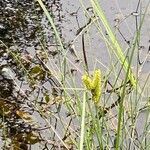Rhizome with long and slightly stout stolons. Culms loosely tufted, 40-100 cm tall, rather stout, obtusely trigonous, smooth, bladeless sheathed at base, rudimentary sheaths usually disintegrating into fibers. Leaves longer than culm, blades gray-green, 2-5 mm wide, flat, ± stiff, with transverse septate nodes between veins, scabrid on margins. Involucral bracts leaflike, lower involucral bracts longer than spike, shortly sheathed or not sheathed, upper involucral bracts not sheathed. Spikes 3-6; terminal 2-4 spikes, rarely only 1 spike, male, approximate, linear-cylindric, 1-3.5 cm, sessile or subsessile; remaining spikes female, lower spikes remote, cylindric, 3-6 × 0.7-0.8 cm, densely many flowered, subsessile or lower spikes shortly pedunculate. Female glumes ferruginous or pale ferruginous, oblong-lanceolate, 3.5-4 mm, membranous, green costate, margins white hyaline, apex acute or obtuse. Utricles yellowish green, slightly longer than or equaling glume, obliquely patent, eventually slightly divergent, ovate or broadly ovate, inflated trigonous, ca. 4 mm, membranous, glabrous, shiny, 4-6-veined abaxially, base subrounded, shortly stipitate, apex abruptly contracted into a medium-sized beak, orifice shortly 2-toothed. Nutlets brown, very loosely enveloped, broadly obovate, trigonous, ca. 1.5 mm, base shortly stipitate; style slender, flexuose, base not thickened; stigmas 3, rather short. Fl. and fr. Jun-Jul.
More
Plants colonial; rhizomes long. Culms terete or very bluntly trigonous in cross section, 8–90 cm, smooth distally. Leaves: basal sheaths brown, occasionally tinged with pinkish red; ligules as long as wide; blades whitish green, U-shaped, with involute margins, widest leaves 1.5–4.5(–7.5) mm wide, papillose adaxially. Inflorescences 10–30 cm; proximal bract 18–45 cm, exceeding but no more than 2.5 times longer than inflorescence; proximal (1–)2–3 spikes pistillate, erect or the proximal ascending, ca. 20–150-flowered, cylindric; terminal (1–)2–4 spikes staminate, well elevated beyond summit of separate pistillate spikes. Pistillate scales lanceolate ovate, 2.5–4.5(–8.8) × 0.8–1.6 mm, mostly shorter than perigynia, margins entire, apex acute to acuminate (rarely acuminate-awned). Perigynia spreading, often green or straw colored, 9–15-veined, veins running into beak, ovate, 3.6–5.8 × 1.7–2.8 mm, apex contracted; beak (1–)1.2–2 mm, bidentulate, smooth, teeth straight, 0.2–0.7 mm. Stigmas 3. Achenes brown, symmetric, not indented, trigonous, smooth. 2n = 60.
A sedge. These grow in clumps and have grass like leaves and solid stalks. The rhizome has long stout stolons or runners. The stems are 40-100 cm tall. They are 3 sided. The leaves are grey-green and 2-5 mm wide. They are flat and stiff. There are 3-6 flowering spikes. The seeds are brown and have a loose covering. They are 3 sided and 1.5 mm long.
Similar to no. 218 [Carex utriculata Boott], and often confused with it, but the lvs papillate-glaucous on the upper surface, mostly 1.5–4 mm wide, tending to be involute; perigynia avg smaller; 2n=60, 72, 74, 76. Wet soil or shallow water; circumboreal, s. to n. Mich. and n. Minn.
A characteristic species of pools in acid bogs, also found in ditches, swamps, wet meadows, wet woodland and the margins of lakes, ponds, river and streams usually in oligotrophic or mesotrophic conditions, occasionally in dune-slacks.
More
It is a temperate plant. It grows in swamps and meadows in high mountain regions in north China at about 2,400 m above sea level.
